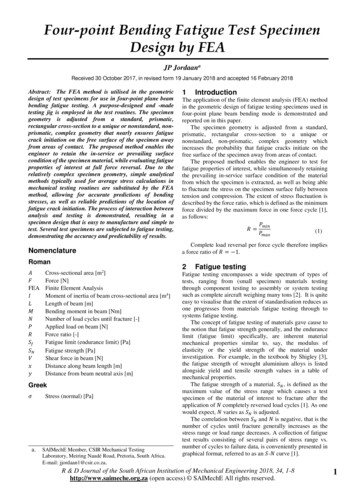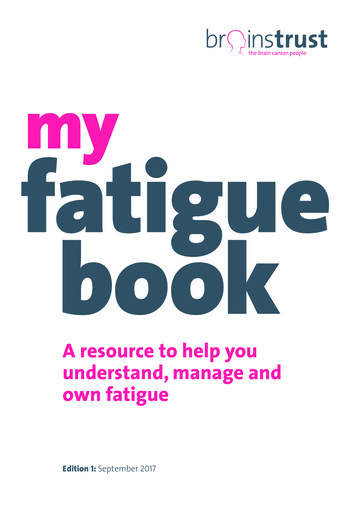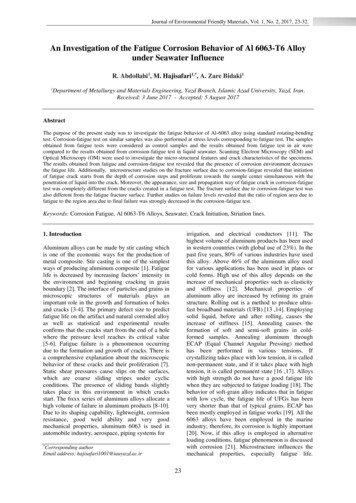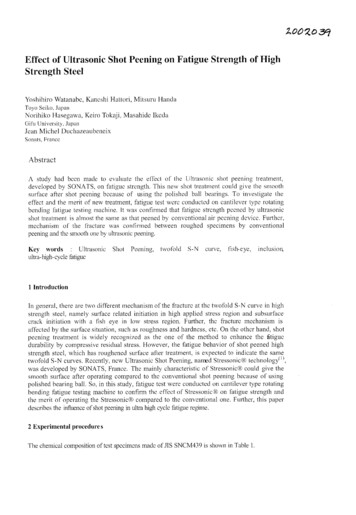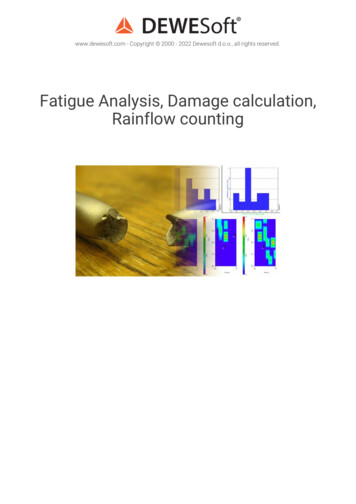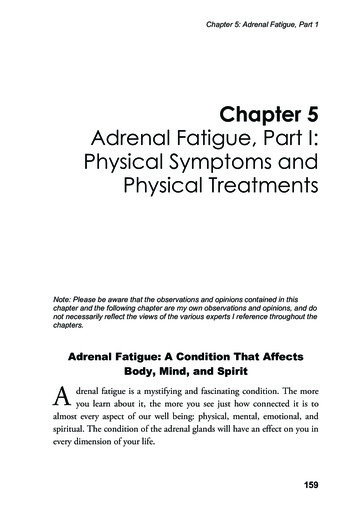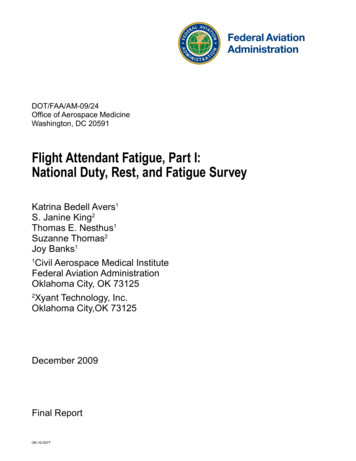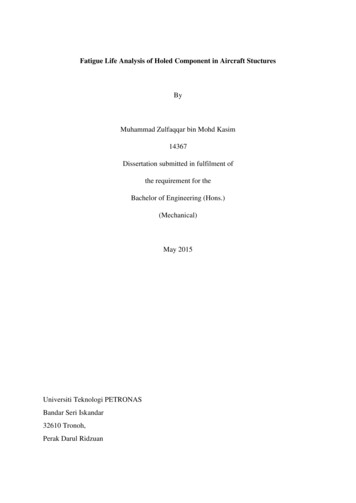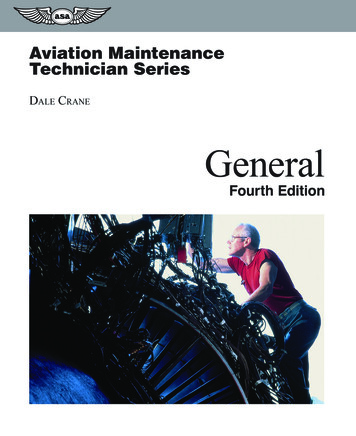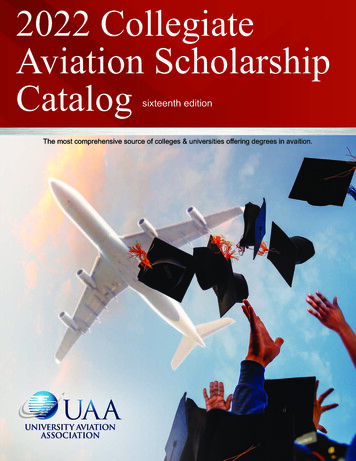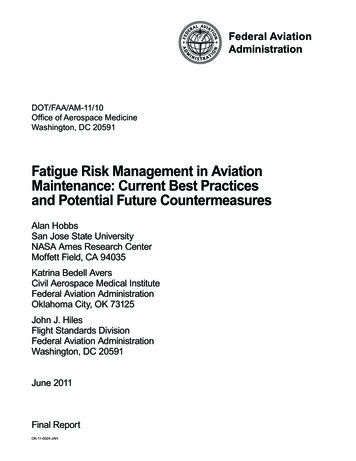
Transcription
Federal AviationAdministrationDOT/FAA/AM-11/10Office of Aerospace MedicineWashington, DC 20591Fatigue Risk Management in AviationMaintenance: Current Best Practicesand Potential Future CountermeasuresAlan HobbsSan Jose State UniversityNASA Ames Research CenterMoffett Field, CA 94035Katrina Bedell AversCivil Aerospace Medical InstituteFederal Aviation AdministrationOklahoma City, OK 73125John J. HilesFlight Standards DivisionFederal Aviation AdministrationWashington, DC 20591June 2011Final ReportOK-11-0024-JAH
NOTICEThis document is disseminated under the sponsorshipof the U.S. Department of Transportation in the interestof information exchange. The United States Governmentassumes no liability for the contents thereof.This publication and all Office of Aerospace Medicinetechnical reports are available in full-text from the CivilAerospace Medical Institute’s publications Web ports
Technical Report Documentation Page1. Report No.2. Government Accession No.DOT/FAA/AM-11/103. Recipient's Catalog No.4. Title and Subtitle5. Report DateFatigue Risk Management in Aviation Maintenance: Current BestPractices and Potential Future CountermeasuresJune 20117. Author(s)8. Performing Organization Report No.126. Performing Organization Code3Hobbs A, Avers KB, Hiles JJ9. Performing Organization Name and Address10. Work Unit No. (TRAIS)1San Jose State UniversityNASA Ames Research CenterMoffett Field, CA 940352FAA Civil Aerospace Medical InstituteOklahoma City, OK 7312511. Contract or Grant No.3FAA Flight Standards DivisionWashington, DC 2059112. Sponsoring Agency name and Address13. Type of Report and Period CoveredOffice of Aerospace MedicineFederal Aviation Administration800 Independence Ave., S.W.Washington, DC 2059114. Sponsoring Agency Code15. Supplemental NotesWork was accomplished under approved task AM-A-08-HRR-52116. AbstractThe unregulated hours and frequent night work characteristic of maintenance can produce significant levels ofemployee fatigue, with a resultant risk of maintenance error. Fatigue Risk Management Systems (FRMS) arewidely used to manage fatigue among flight crew and drivers of commercial vehicles, but comprehensiveapproaches to fatigue risk management are still uncommon within maintenance organizations. In the widertransport industry, the objective of most FRMS has been to reduce fatigue to an acceptable level. Two additionalobjectives can be identified for FRMS in the maintenance environment: reducing or capturing fatigue-relatederrors, and minimizing the harm caused by fatigue-related errors. A range of countermeasures can help to achievethese three objectives in aviation maintenance. Some of these countermeasures are currently being applied withinthe industry, while others may become feasible in the future.The data available on best practices for fatigue risk management in aviation maintenance are continuallyevolving. This should be considered an interim report.17. Key WordsMaintenance, Human Fatigue, Alertness, Fatigue RiskManagement, FRMS, Countermeasures, Hours-of-Service19. Security Classif. (of this report)Unclassified20. Security Classif. (of this page)UnclassifiedForm DOT F 1700.7 (8-72)18. Distribution StatementDocument is available to the public through theDefense Technical Information Center, Ft. Belvoir, VA22060; and the National Technical InformationService, Springfield, VA 2216121. No. of Pages3022. PriceReproduction of completed page authorizedi
Preface"I have been a lead mechanic for over 25 years for the airlines. Have I ever worked tired when I shouldn’t have, or seenothers who worked tired when they shouldn’t have? Yes. Do other mechanics, leads, and management know about it? Yes.Have mistakes been made due to fatigue? Yes . When errors are made, we catch them, and repair them, and press on withthe job. We don’t document them. We simply fix them."—Anonymous maintenance technicianThis matter-of-fact statement made by an anonymousmaintenance technician illustrates both the prevalenceof fatigue and the current strategy that is used by manytechnicians in the aviation maintenance industry. Fatiguecan affect all maintenance tasks via impaired judgment,difficulty focusing attention, memory lapses, reducedmood and motivation, and other performance effects.The reduction of aviation accidents and incidents causedby fatigue is one of the issues on the National Transportation Safety Board’s (NTSB’s) list of “most wanted” safetyimprovements. In 1997, the Board recommended thatthe Federal Aviation Administration “Review the issueof personnel fatigue in aviation maintenance; then establish duty time limitations consistent with the currentstate of scientific knowledge for personnel who performmaintenance on air carrier aircraft” (NTSB, 1997). TheNTSB has also urged the FAA to provide guidance tomaintenance personnel on the issue of fatigue.There is an extensive literature on fatigue in the transportation industry (Dinges, 1995; Mitler, Carkadon,Czeisler, Dinges & Graeber, 1988), including severalFAA studies on fatigue in maintenance (Hackworth,Holcomb, Banks, Schroeder, & Johnson, 2007; Johnson,Mason, Hall & Watson, 2001). Much has also beenwritten about fatigue risk management (Fourie, Holmes, Bourgeois-Bougrine, Hilditch, & Jackson, 2010);however, there has been a lack of information on fatiguecountermeasures specific to aviation maintenance. Thisdocument is intended to provide an overview of solutionsto the problem of fatigue in the aviation maintenanceenvironment. Some of these solutions are currently beingapplied. Others are potential countermeasures that maybecome feasible in the future.iii
AcknowledgmentsThis report was supported and partially funded by the FAA Air Traffic Organization Human FactorsResearch and Engineering Group. Work was accomplished under approved task AM-A-08-HRR-521.We thank the many people who contributed to this report, and acknowledge the assistance providedby members of the FAA Maintenance Fatigue Work Group.v
ContentsIntroduction . . . . . . . . . . . . . . . . . . . . . . . . . . . . . . . . . . . . . . . . . . . . . . . . . . . . . . . . . . . . . . . . . . . . . . . . . . . 1Fatigue Risk Management Principles. . . . . . . . . . . . . . . . . . . . . . . . . . . . . . . . . . . . . . . . . . . . . . . . . . . . . 1Characteristics of Maintenance Work That can Assist With Fatigue Management . . . . . . . . . . . . . . . . . . 1Employer and Employee Responsibilities. . . . . . . . . . . . . . . . . . . . . . . . . . . . . . . . . . . . . . . . . . . . . . . . . . 2Introducing Three Objectives of Fatigue Risk Management. . . . . . . . . . . . . . . . . . . . . . . . . . . . . . . . . . . . 2Objective 1—Reduce fatigue. . . . . . . . . . . . . . . . . . . . . . . . . . . . . . . . . . . . . . . . . . . . . . . . . . . . . . . . . . . . . . . 3Hours of Service Limits Imposed by Aviation Authorities . . . . . . . . . . . . . . . . . . . . . . . . . . . . . . . . . . . . . 3Hours of Service Policies of Non-Government Agencies and Airlines. . . . . . . . . . . . . . . . . . . . . . . . . . . . . 4Scientific Scheduling Models. . . . . . . . . . . . . . . . . . . . . . . . . . . . . . . . . . . . . . . . . . . . . . . . . . . . . . . . . . . 5Napping Strategies. . . . . . . . . . . . . . . . . . . . . . . . . . . . . . . . . . . . . . . . . . . . . . . . . . . . . . . . . . . . . . . . . . . 5Training and Educational Material. . . . . . . . . . . . . . . . . . . . . . . . . . . . . . . . . . . . . . . . . . . . . . . . . . . . . . . 5Excused Absences. . . . . . . . . . . . . . . . . . . . . . . . . . . . . . . . . . . . . . . . . . . . . . . . . . . . . . . . . . . . . . . . . . . . 6Medical Treatment. . . . . . . . . . . . . . . . . . . . . . . . . . . . . . . . . . . . . . . . . . . . . . . . . . . . . . . . . . . . . . . . . . . 6Objective 2—Reduce or Capture Fatigue-Related Errors . . . . . . . . . . . . . . . . . . . . . . . . . . . . . . . . . . . . . . . 6Measures Directed Towards Individuals. . . . . . . . . . . . . . . . . . . . . . . . . . . . . . . . . . . . . . . . . . . . . . . . . . . 7Measures Directed Towards At-Risk Tasks. . . . . . . . . . . . . . . . . . . . . . . . . . . . . . . . . . . . . . . . . . . . . . . . . 8Objective 3—Minimizing the Harm Caused by Fatigue-Related Errors. . . . . . . . . . . . . . . . . . . . . . . . . . . . 10Summary and Conclusions. . . . . . . . . . . . . . . . . . . . . . . . . . . . . . . . . . . . . . . . . . . . . . . . . . . . . . . . . . . . . . . . 11References. . . . . . . . . . . . . . . . . . . . . . . . . . . . . . . . . . . . . . . . . . . . . . . . . . . . . . . . . . . . . . . . . . . . . . . . . . . . . 13Appendix A:Model Rest and Duty Limitations for Persons Performing Maintenance Functions on AOCHolder Aircraft. . . . . . . . . . . . . . . . . . . . . . . . . . . . . . . . . . . . . . . . . . . . . . . . . . . . . . . . . . . . . A1Appendix B:Folkard’s (2003) recommendations on Aircraft Maintenance Hours of Service. . . . . . . . . . . . . . B1Appendix C:International Federation of Airworthiness Recommendations on Duty Times forAviation Maintenance. . . . . . . . . . . . . . . . . . . . . . . . . . . . . . . . . . . . . . . . . . . . . . . . . . . . . . . C1Appendix D: Fatigue Policy of Airline B. . . . . . . . . . . . . . . . . . . . . . . . . . . . . . . . . . . . . . . . . . . . . . . . . . . . D1Appendix E:A Fatigue Risk-Assessment System in use by a Maintenance Organization. . . . . . . . . . . . . . . . . E1Appendix F:Self-Assessment Scales. . . . . . . . . . . . . . . . . . . . . . . . . . . . . . . . . . . . . . . . . . . . . . . . . . . . . . . . . F1Appendix G: International Federation of Airworthiness Fatigue Control Recommendations. . . . . . . . . . . . . G1vii
List of AcronymsAcronym------ DefinitionAMC----------- Acceptable Means of ComplianceAMT----------- Aircraft Maintenance TechnicianAOG----------- Aircraft on GroundCAA------------ Civil Aviation Authority (UK)CAAC --------- Civil Aviation Administration of ChinaCAP ----------- Civil Aviation PublicationCAS------------ Circadian Alertness SimulatorCASA --------- Civil Aviation Safety Authority (Australia)CASR---------- Civil Aviation Safety RegulationEASA----------- European Aviation Safety AgencyETOPS-------- Extended-Range Twin-Engine OperationsFAA------------ Federal Aviation AdministrationFAID----------- Fatigue Audit InterDyneFAST----------- Fatigue Avoidance Scheduling ToolFRMS---------- Fatigue Risk Management SystemGM------------- Guidance MaterialHOS----------- Hours of ServiceICAO---------- International Civil Aviation OrganizationIFA------------- International Federation of AirworthinessMRO----------- Maintenance Repair and OverhaulNPRM--------- Notice of Proposed RulemakingNTSB---------- National Transportation Safety BoardPERCLOS---- Percentage of Eye ClosureSAFTE--------- Sleep Activity Fatigue and Task EffectivenessSMS------------ Safety Management SystemUK------------- United Kingdomix
Fatigue Risk Management in Aviation Maintenance:Current Best Practices and PotentialFuture CountermeasuresIntroductionFatigue risk management is an application of theSafety Management System (SMS) model, throughwhich hazards are identified and risk is managed witha comprehensive approach that extends beyond regulatory compliance (FAA, 2011a). FRMS can be integratedwithin an existing SMS or can be developed as a standalone system. The following principles can be found inthe fatigue risk management literature: An FRMS requires a systemic approach, involving company policies, incident reporting and analysis systems,proactive risk assessment, and the other elements of ageneral safety management system (Australian NationalTransport Commission, 2004; FAA, 2010; TransportCanada, 2007a, 2007d). Effective fatigue risk management requires a partnership between the employer and the employee, as eachcan contribute uniquely to solutions (Dawson, 2000;Fletcher, 2007; Transport Canada, 2007b, 2007c). It is unrealistic to aim for “zero fatigue” in all cases.An appropriate objective for fatigue risk managementis to ensure that risks are as low as reasonably practical(Stewart & Holmes, 2008).Aviation maintenance personnel face a particular riskof fatigue due to night shift work, the potential for longand unregulated duty times, and the sleep disruption thatcan result from these working conditions (Hackworth,Holcomb, Banks, Schroeder, & Johnson, 2007; Johnson,Mason, Hall, & Watson, 2001; Johnson, 2008). Fatiguemanagement in aviation maintenance has received increasing attention from international bodies, national aviationauthorities, investigation agencies, airlines, and maintenance and repair organizations (MROs). The purpose ofthis discussion paper is to summarize the current stateof fatigue risk management in aviation maintenance andto examine emerging approaches to the management ofmaintainer fatigue.This report presents best practices for maintenancefatigue risk management, drawn from published sourcesand the experience of industry personnel. The informationon industry practices was obtained from 50 individualsin aviation authorities, airlines, maintenance organizations, and the internal company documents they kindlyprovided.Most of the fatigue risk management approaches inindustry have been designed for continuous-controltasks such as driving a vehicle or operating an aircraft.In such tasks, one of the major fatigue-related threatsis an unwanted sleep episode, in the form of either anextended period of sleep or a microsleep. In maintenance,falling asleep at work is not the main hazard created byfatigue. Rather, a fatigued maintainer is at increased risk ofmaintenance errors due to impaired mental functioning.This distinction, while seemingly trivial, has importantimplications for fatigue risk management in aviationmaintenance.Fatigue Risk Management PrinciplesIn recent years, comprehensive fatigue risk management approaches have been adopted in aviation and roadtransport, supplementing, or in some cases replacing,older Hours of Service (HOS) approaches. Fatigue RiskManagement Systems (FRMSs) have been promoted bythe International Civil Aviation Organization (ICAO,2008), the Federal Aviation Administration (2010), theEuropean Aviation Safety Agency (EASA, 2009) TransportCanada (2007a), the Civil Aviation Safety Authority ofAustralia (CASA, 2009a), and agencies in the road andrail transport industries (Australian National TransportCommission, 2004; Gertler, Popkin, Nelson & O’Neil,2002). The FAA has defined FRMS as: a data driven and scientifically based processthat allows for continuous monitoring and management of safety risks associated with fatigue-relatederror. It is part of a repeating performance improvement process. This process leads to continuous safetyenhancements by identifying and addressing fatiguefactors ” (FAA, 2010, p. 3).Characteristics of Maintenance Work That canAssist With Fatigue ManagementAlthough maintenance personnel must contend withsignificant fatigue risks, some characteristics of aircraftmaintenance provide opportunities to mitigate the hazardspresented by fatigue.First, maintenance tasks tend to be self-paced ratherthan externally paced, as defined by Broadbent (1953).Although much maintenance work is performed under1
time pressure, a maintainer conscious of impaired performance may be able to pause a task, trade speed foraccuracy, or repeat a step as necessary.Second, in some cases, there are opportunities to modifymethods of task performance in maintenance. In manycases, task cards can be modified, and error-capturingbarriers such as secondary inspections or operational/functional checks can be introduced.Third, maintenance organizations sometimes haveflexibility to choose the time at which certain tasks areperformed. In such cases it may be possible to schedulethe most safety-critical tasks, or those most susceptible tofatigue, at times when fatigue will have the least impact.Finally, maintainers are rarely required to travelacross time zones while on duty. Consequently, jet lagand travel-related circadian rhythm disruption, whichare major considerations for flight crew FRMS, are notusually relevant in the maintenance environment. Theexception is when maintainers must travel to a remotework site to perform a task.In summary, maintenance organizations face a uniqueset of fatigue-related challenges but also have access to aunique set of potential solutions. As a result, FRMS inmaintenance can involve a wider range of countermeasuresthan comparable systems developed for flight crews orvehicle drivers.a partnership with shared responsibility between theemployee and the employer.Workplace factors include working hours, staffinglevels, and the availability of break periods. Personalfactors leading to fatigue can include social and familycommitments, commute time, second jobs, and medical conditions that may reduce the quality or quantityof sleep. The employee has a responsibility to ensure,as much as possible, that he or she is rested and “fit forduty” before reporting for work.The not-for-profit International Federation of Airworthiness (IFA) has made the following statement in relationto the issue of maintainer fatigue: “Responsibility for theestablishment and control of employees’ duty hoursand rest times does not solely rest with the company/employer. Individuals have a responsibility to make use ofthe opportunities and facilities for rest periods provided.They are also responsible for planning and using their restperiods properly in order to minimize incurring fatigue”(Jauregui & Hosey, 2007).Introducing Three Objectives of Fatigue RiskManagementFatigue risk management interventions can be characterized not only in terms of the activities that comprisethe approach (such as hours of service limits and incidentreporting systems) but also the intended objectives of theseactivities. An approach common to many risk management systems is a distinction between controls aimed athazard prevention and controls directed at risk mitigation(International Organization for Standardization, 2009;Employer and Employee ResponsibilitiesThe conditions that produce fatigue originate not onlyin the workplace but also in the employee’s personal life(see Figure 1). Effective fatigue risk management requiresFigure 1. Workplace and personal factors contributing to employee fatigue. Adapted from theAustralian National Transport Commission (2004).2
Objective 1 - Reduce fatigueReason & Hobbs, 2003). Consistent with this distinction,three potential objectives of fatigue risk management canbe identified:1. Reduce fatigue. The first and most obvious objectiveof fatigue countermeasures is to reduce the level offatigue experienced by personnel at work. This is theapproach most commonly referred to when considering fatigue risk management. Hours of Service (HOS)limits and the re-design of shift schedules are examplesof interventions intended to meet this objective.2. Reduce or capture fatigue-related errors. The secondclass of interventions are designed to break the linkbetween fatigue and performance decrements. Thiscan be achieved by reducing the probability that afatigued maintainer will make an error or capturingfatigue-related errors once they have occurred. Workbreaks and additional task steps designed to captureerrors are examples of such interventions.3. Minimize the harm caused by errors. A final approach is to minimize, where possible, the operationalconsequences of fatigue-related errors. An exampleis a policy that prevents a fatigued maintainer fromperforming the same task on both engines of a twinengine aircraft. The policy is not intended to reducefatigue or reduce the probability of error. Rather, itminimizes the operational impact of an error, shouldone occur.Fatigue reduction interventions are intended tominimize fatigue in the workplace, while recognizingthat its complete elimination is not always practical.Interventions include HOS limits (whether voluntaryor mandatory), scientific scheduling, napping strategies,education, excused absences, and in certain cases, medicaltreatment. These interventions are described in detail inthe following sections.Hours of Service Limits Imposed by AviationAuthoritiesIn the U.S., the only hours of service (HOS) limitcurrently applying to aviation maintenance is Title 14of the Code of Federal Regulations (CFR) Part 121,§121.121.377. It requires that a person performingmaintenance be relieved of duty for at least 24 hours inany seven consecutive days or the equivalent within acalendar month. In effect, a person could work up to 52days straight, in a period of two consecutive months, andstill be in compliance with the regulation (FAA, 2011b).The FAA regulation, however, only applies to personnelmaintaining aircraft operated by part 121 air carriers.As part of its international assistance activities, the FAAformerly provided overseas regulators with model restand duty limitations for maintenance personnel. Theseincluded a 12-hour limit on HOS, extendable to 16 hoursin the case of unscheduled maintenance (see Appendix A).An FAA work group is currently developing draft HOSguidelines for maintenance. It is uncertain whether theFAA will propose HOS regulations at some future time.The New Zealand Civil Aviation Authority (2007) isone of the few regulatory bodies to specify duty limitsfor maintenance personnel. New Zealand Civil AviationRule Part 43.53 requires that before performing work,maintenance personnel must have had at least eight hoursoff duty in the preceding 24 hours and at least four periodsof 24 consecutive hours of break in the preceding month.The Civil Aviation Administration of China (CAAC)(2005) specifies a maximum duty time for aviation maintenance personnel of eight hours per day, with a maximumof 40 hours per week. Extended duty is permitted underspecial circumstances, up to a total of 11 hours per day.However, total monthly overtime is limited to 36 hoursper month.The European Aviation Safety Agency (EASA) and theUnited Kingdom Civil Aviation Authority (UK CAA) donot specify HOS limitations for maintenance personnel;however, the UK CAA commissioned Professor SimonFolkard (2003) to develop comprehensive guidelines forbest practices. Five key items from Folkard’s guidelines are:As shown in Figure 2, each of three objectives can beconsidered as a layer of defenses in the “Swiss Cheese”model (Reason, 1990). Each objective will be consideredin more detail in the following sections.FigureThreeobjectivesobjectivesof fatigueriskFigure 2.2.Threeof fatiguerisk managementmanagement interventions.interventions.3
There should be a 12-hour limit on shift duration No shift should be extended beyond 13 hours byovertime A break of at least 11 hours should occur between shifts There should be a work break every four hours A month’s notice of work schedules should be provided ersonnel. Examples of HOS policies from several operaptors are given below: One airline limits planned shifts to 12 hours duration, with the possibility of extending to 13 hours.The weekly working hours are limited to 48 hours intotal. (The maintenance fatigue policy of this airlinecan be found in full in Appendix D.) Another airline possesses a much more liberal HOSpolicy, permitting up to 20 hours of work attendancein a 24-hour period and up to 36 work hours, exclusiveof lunch, in any two consecutive 24-hour days. Suchwork hours could produce significant levels of fatigue. An MRO reported that it had adopted the Folkardrecommendations as its HOS policy, applying a limitof 12 hours, with the potential to extend to 13 hourswith overtime.As Folkard (2003) notes, predictability in work schedules enables staff to plan their activities to ensure thatthey arrive at work well-rested. The Folkard guidelinescan be found in full in Appendix B.Folkard’s guidelines have had a worldwide impact.They have been adopted by at least one regulatory agency(Civil Aviation Department, 2009), have been included inthe UK CAA advisory document for part 145 operators(CAA, 2003), and in a guidance document for maintenance organizations released by ICAO (2003).In Australia, CASA does not specify HOS limits formaintenance personnel. However, a new CASA regulation effective in June 2011 (CASA, 2009b), based onEASA part 145, makes it an offense for a maintenanceorganization to permit a maintainer who is significantlyimpaired by fatigue or a psychoactive substance to carryout maintenance on an airline aircraft. The regulationalso requires organizations to ensure that schedulespermit maintainers to take sufficient rest. The rules alsoprohibit organizations from requiring people to continueworking if their capacity to carry out maintenance workhas become significantly impaired (CASA, 2004). TheAcceptable Means of Compliance (AMC) associated withCASR 145 notes that a FRMS is an acceptable means tocomply with the intent of those parts of the regulationdealing with fatigue. CASA recommends that operatorsconsider adopting Folkard’s HOS guidelines as part oftheir fatigue risk management system (CASA, 2009b).Special circumstances, such as an aircraft on ground(AOG) at a remote station, can require extended dutytimes. In these situations, a team of maintenance personnel may need to travel significant distances across timezones and then work for an extended period to return theaircraft to service. Typically, the work will be of a highlytechnical nature, since it is assumed the aircraft is AOGbecause a flight-critical system is affected. In many cases,maintenance personnel are eager to undertake these tasks(often referred to as “field trips” or “away jobs”) becausesignificant overtime pay can be involved.Several airlines have taken steps to minimize theimpact of fatigue when maintenance personnel musttravel to a remote location. Some airlines will send twocrews for large jobs and provide hotel accommodationto allow crews to alternate rest periods. In other cases,restrictions similar to flight crew duty times are applied.One airline has a detailed policy for maintenance tasksrequiring travel. This policy includes: A break of eight hours (including food and formallodging) should be provided and used by individualsconcerned When necessary, relief personnel should be dispatchedfor tasks with durations greater than 18 hours Where relief personnel are not feasible due to resourcelimitations or distance, then at least one additionalindividual should be allocated to the effort for thepurpose of staggering total duty time more evenlyamong personnel Where possible, personnel selected for field tripsshould be at the start of their normal duty shift, asopposed to those at the end of their normal shift orday-off rotation If it is necessary to drive to and from a remote worksite,the fatiguing effects of driving should be taken intoaccount when planning the taskHours of Service Policies of Non-GovernmentAgencies and AirlinesThe International Federation of Airworthiness has published non-binding recommendations for maintenanceduty periods (Jauregui & Hosey, 2007). (See AppendixC). In summary, the IFA recommendations specify that: No scheduled shift should exceed 12 hours No shift should be extended beyond 16 hours There should be no more than 72 hours scheduledduty in a seven-day period If 12-hour night shifts are scheduled, there should beno more than four in any seven-day periodIn the absence of regulatory limits, several airlines andMaintenance Repair and Overhaul (MRO) organizations have introduced HOS limits for their maintenance4
Napping StrategiesNaps can be helpful either as a preventative measure,as when taken before reporting for a night of shiftworkor as a way of improving alertness during a night shift(Ficca, Axelsson, Mollicone, Muto, & Vitiello, 2010).Controlled studies have shown that even a brief sleepepisode can result in performance improvements. Forinstance, Purnell, Feyer and Herbison (2002) foundthat the vigilance performance of aircraft maintenancepersonnel on the first of two consecutive 12-hour nightshifts (1900 – 0700) was improved by a 20-minute naptaken at around 3 a.m. For reasons that are unclear, noimprovement was found on the second of the two nightshifts. Other studies have found that brief controlled sleepsof less than 40-minute duration can significantly increasethe alertness of airline pilots, resulting in fewer lapses andreduced response time to stimuli (Rosekind et al., 1994).Similar benefits have been found for air traffic controllers(Della Rocco, Comperatore, Caldwell, & Cruz, 2000)and truck drivers (Macchi, Boulos, Ranney, Simmons, &Campbell, 2002). Napping as a fatigue countermeasurein maintenance may face resistance from airlines andregulators. However, informal napping arrangements areknown to already occur during maintenance nightshiftsas a countermeasure to extreme fatigue (Rhodes, Lounsbury, Steele, & Ladha, 2003). One airline reported thatit provides beds to let maintenance workers nap at theend of their shifts before driving home.A potential hazard associated with napping is thatsleep periods lasting more than about 40 minutes mayproduce “sleep inertia,” a feeling of grogginess and disorientation that may persist for some time after awakening(Van Dongen et al., 2001; Wertz, Rhonda, Czeisler, &Wright, 2006).A potential risk with maximum HOS limits is thatthey become de facto standard working hours, ratherthan upper bounds on normal working hours. For example, the standard airline maintenance shift durationin Australia is 12 hours, at the upper limit of Folkard’srecommendations.Scientific Scheduling ModelsIn recent years, software modeling systems have beenincorporated into many FRMS. Software models haveadvantages over HOS limits as they can take into accountcircadian variations in alertness, and sleep obtained, toproduce an est
Civil Aerospace Medical Institute Federal Aviation Administration Oklahoma City, OK 73125 John J. Hiles Flight Standards Division Federal Aviation Administration Washington, DC 20591 June 2011 Final Report Fatigue Risk Management in Aviation Maintenance: Current Best Practices and Potential Future Countermeasures DOT/FAA/AM-11/10 Office of .
